How to Create Your USP, Value Proposition, and Elevator Pitch [the easy way]
Why should someone do business with you?
What can you do to help them solve the problem they are facing?
What makes your business different?
Why should they choose you?
![Illustration of elevator with text "Create your USP, Value Proposition, and Elevator Pitch [the easy way]"](http://www.marketingnoob.com/wp-content/uploads/2018/09/elevator-main-3.jpg)
One of the biggest challenges in marketing is being able to clearly define what sets you apart and the value you bring that others do not.
This step-by-step guide is going to help you fix this.
The following simple steps will help you create your USP (Unique Selling Proposition), Customer Value Proposition, and Elevator Pitch.
The first step is a quick overview of why it is so important to create these core marketing messages.
On the surface, these marketing messages may seem complicated and intimidating… they are not. The key is first establishing the core building blocks found in every USP, Value Proposition, and Elevator Pitch.
Once you have your core building blocks created, your marketing messages come together with ease.
How does that sound?
Download the Elevator Pitch
Companion Workbook
Before you dive too deep into the content below, be sure to download the companion workbook.
This workbook was created so you can fill in the blanks as you proceed through the contents of this blog post.
Okay… now that is out of the way, roll up your sleeves and get to work.
Don’t Waste the Opportunity to
Make an Unforgettable First Impression

Everyone knows the saying “You Never Get a Second Chance to Make a First Impression”.
So, why are so many first impression opportunities wasted because of a bland, poorly constructed marketing message?
This window of opportunity is short… like seconds short. Thousands of advertisements scream for consumer attention each and every day.
How do you make sure that your message is heard?
How do you stand out from this noisy crowd?
It is not done by screaming louder and more often.
You need to focus on what you say more than ever. You need to create a clear, concise marketing message that will cut through the noise and show everyone why your business is incredible.
This step-by-step guide will show you exactly how to create the following marketing messages:
- Unique Selling Proposition (USP)
- Customer Value Proposition
- Elevator Pitch
Let’s get started.
Where You Encounter First Impressions

There are several ways you can encounter that “First Impression” moment with a potential customer.
- Meeting someone new at a networking event, business conference, backyard BBQ, or in an elevator.
- Their first visit to your website.
- Someone calling or visiting your business for the first time.
- Being referred by family, friends, or clients.
In each of these instances, you have seconds to project your first impression.
What type of first impression are you leaving?
This is where having well-crafted marketing messages is the difference maker.
At this point, you might be confused and intimidated by the thought of creating a USP, Value Proposition, and Elevator Pitch.
Don’t be worried… you are not alone. Most people find this very challenging and either (1) never get around to it OR (2) create lackluster marketing messages that have zero impact and are never remembered.
The process of creating these marketing messages is simplified by breaking them down into smaller components called core building blocks. Once you have these core building blocks at your fingertips, creating your marketing messages is simple.
Before defining the building blocks, you need to understand why they are important.
Learning the Basics:
Determining Your Building Blocks

Taking a Page Out of Mr. Miyagi’s Playbook
The 80s movie Karate Kid was the inspiration for the core building blocks of your marketing messages.
Let’s break down the premise of the movie for the 3 of you out there that haven’t seen it.
A kid named Daniel moves from New Jersey to California.
He experiences all the typical struggles of a teenager moving to a new town and trying to fit in with a new group of friends.
The maintenance man (Mr. Miyagi) for the apartment complex he lives in agrees to teach Daniel karate. His training begins with Daniel doing a whole bunch of chores. Waxing cars, sanding decks, painting the fence, and painting the house. Daniel was forced to do each chore in a very specific way.
One day, Daniel’s frustration explodes and he confronts Mr. Miyagi about all the chores he has been doing. When will he begin his karate training? Mr. Miyagi reveals to Daniel that these chores he has been doing were actually training exercises for his karate training. The motions of each activity (chore) mirror a defensive karate move. Mr. Miyagi proceeds to demonstrate all that Daniel has learned by showing him how to “wax on – wax off” and defend an attack.
Mr. Miygai was training Daniel the basic building blocks of defense without him even knowing it. [MIND BLOWN]
Mr. Miyagi broke down a complex action, like defending an attacker, into moves that mirrored motions you do around the house. This led to the following revelations. First, the most complicated things can be broken down into core components or core building blocks. Second, it takes practice to get good at something. You have to perform the same actions over and over to master them.
Mr. Miyagi’s teaching can be applied to many different areas of life.
They apply perfectly as you begin to create your core marketing message.
The 3 Key Things You Must Know to Begin
The core building blocks are centered around fully understanding these three main components of your business. Chances are, you already know much of what is needed. All you need is guidance to extract the information.
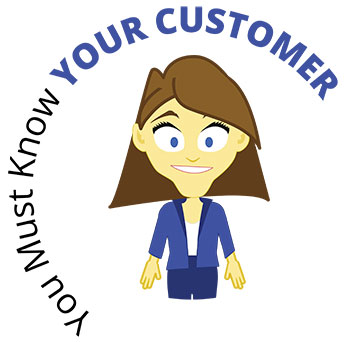


Once you understand these 3 key main components of your business, you can then extract the core building blocks that will be used to create your marketing message.
It’s crucial that you go through each step here.
This step of this whole entire process is the special sauce of your marketing messages. The more you understand Your Customer, You, and Your Competition, the better defined your core building blocks will be leading to the best version of your marketing messages.
Shortcuts or skipping around will lead you to create another bland marketing message that no one cares about and gets lost in the noise.
Let’s get started on creating our building blocks.
Getting to Know Your CUSTOMER
The first thing you need to do is get to know Your Customer.
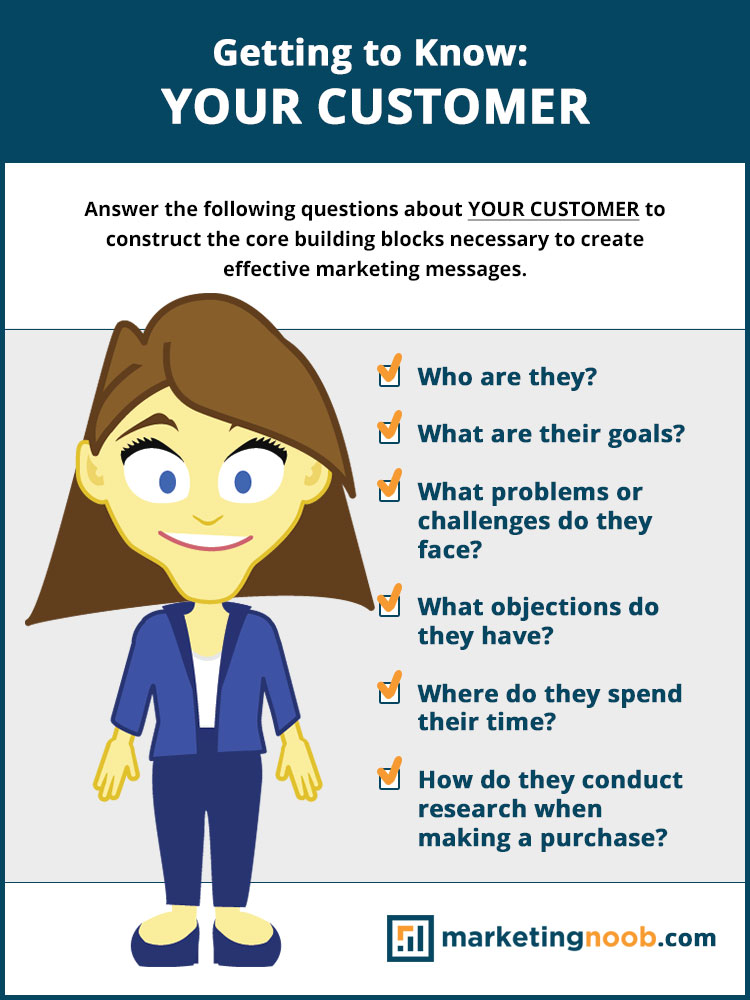
All too often, business owners try to market to the masses. They want to appeal to everyone that might be a potential customer.
This is not the route to take.
When you speak to everyone, you connect with no one.
Chances are, you already have a really good idea of who, specifically, you want to do business with. You know that certain customer type that you prefer and would love to see walk through your door all day long.
You are going to take this a step further and formally create Buyer Personas which will serve as a guide for creating marketing messages. After all, you want to make sure you are speaking to the right people.
Focus on Your Best Customer
Not all customers are created equal.
Some are good customers that appreciate what you provide them. Others are bad customers that have unrealistic expectations, do not see the value you provide, haggle price at every turn, or take forever to pay you.
You want to focus on your best customer. They are beyond pleased with what you provide, see value in the price you charge, are a pleasure to work with, and they refer you to others.
This is the customer you wish you could replicate over and over again.
This is the customer you want to focus your marketing messages on.
Your goal is to learn as much about this individual customer as possible. The more you understand them the better you can connect with them.
Here are some questions you should ask when creating buyer personas:
- Who are they? – Go deeper than scratching the surface. Take time to really understand who they are. Again, focus on your best customer so you can attract more of them.
- What are their goals? – What are they trying to accomplish? Determine the desired end result from your solution. Really explore all options and don’t simply settle for the first thing that pops in your head. Dig deep to come up with 5-10 possible goals of your best customer.
- What problems or challenges do they face? – Someone usually faces a problem or challenge when they seek a solution. Understand the problem or challenge and then outline how your solution addresses it.
- What objections do they have? – What reasons do they give for saying no to doing business with you? They may not see value in your solution which can lead to a price objection. Perhaps they do not understand how it can help solve their problem. These will be areas that require additional clarity.
- Where do they spend their time? – Make a list of websites, blogs, trade publications, forums, associations, and organizations they visit when looking for a solution to satisfy their problem or challenge. What social media sites do they use?
- How do they conduct research? – Explore the steps they take at each stage of the buyer’s journey. What are the questions they have when they first become aware of their problem? How do they find potential solutions to solve their problem? What are the main criteria they are basing their decision on who they choose? Think about the type of content they prefer to consume. Do they read blog posts, customer reviews, and scrape forums for comments or do they prefer video content instead?
The discovery process for collecting answers to all these questions will take time. Know that it is time well-spent in the end. The more you understand and detail you get into, the more impact your marketing messages will have in helping you connect with the right people.
Here are some routes you can take for getting answers for creating your buyer persona.
Interview Your Best Customers
Make a list of your best customers. This is the top 5% of your customers that fit that perfect, ideal customer you are seeking.
Call them up and simply tell them that you are trying to attract more customers just like them. They are the mold you wish to use for all future marketing efforts. Chances are, they will be flattered and more than willing to help.
Take advantage of the one-on-one time with them to learn all about the personal experience they had which led to becoming your customer.
- What was the problem or challenge they had?
- What was their desired goal?
- What were the key elements they considered when making their decision?
- Why did they choose you over others?
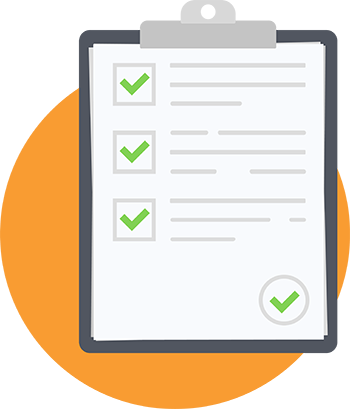 Conduct a survey
Conduct a survey
Perhaps you are just getting started and do not have ideal customers yet. No problem.
The very same intel can be collected using an online survey.
Platforms like SurveyMonkey work great for administering online surveys.
Use the same questions outlined above. One tip to consider is making some of the options for answers multiple choice rather than asking for an open-ended question. Allowing the answer to be a blank field may lead some survey participants to provide short, vague answers that are not helpful to you in the end.
Here are a couple of tips for increasing the response rate of your online survey:
- Be persistent. Even your very best customers that told you they would complete the survey might need to be reminded a couple of times. You might have to make several asks to get someone to take action.
- Make the survey as short as possible. Don’t ask unnecessary questions. The longer the survey, the less likely it will be completed.
- Put the easier questions at the beginning and end of the survey with the harder ones in the middle. Make the first couple of questions really simple like “What is your gender? Male or Female. This will get them active in the survey right away. Save the thought-provoking questions for when they are in the heart of it all.
- Survey responses can vary. You can expect a 10-15% response rate for an external survey.
Talk to Your Team
Talk to the people that interact with your customers all day are a great source of information… your team.
They usually know more than you think and are one of the most valuable resources in the process.
Have one-to-one meetings with team members from marketing, sales, and customer service to learn more about your buyer personas.
In the end, the buyer personas will be an internal document for everyone on your team to reference. Getting everyone involved will also increase their level of buy-in for the use of the buyer personas in their everyday tasks.
Marketing will use the buyer persona document to have a focal point to center marketing campaigns, copy, images, and exposure around.
Sales will use it to visualize who they are crafting an email for speaking to on the phone. This will help them be sure to hone in on the things that matter most to the buyer persona and communicate in a way they find appealing.
Customer Service can use it much like Sales. The buyer persona document will help them visualize who they are speaking to help them be the best representative for the company to that individual.
Use the Internet
The best information for creating your Buyer Personas should come from current customers and your staff. When all else fails, you can turn to the Internet to find answers.
There is a lot of information on the Internet that can be helpful in fleshing out your Buyer Personas. Some will be right on the surface while some information will have to be mining from the depths of cyberspace.
Industry forums are often goldmines for understanding the problems that people are facing. Do some research to find forums that are in your industry and have active people that align with your Buyer Persona. To find forums in your industry, simply search Google for “industry” + forum.
Now that you have your Buyer Personas complete, we need to extract the core building blocks about the customer.
The core CUSTOMER building blocks we need for the creation of our marketing messages are:


Be sure to jot down your CUSTOMER Building Blocks in the Workbook that accompanies this blog post. We will be using these in a moment.
Getting to Know YOU
Who knows YOU better than YOU? Nobody.
People always struggle with this step. They find it difficult to self-evaluate.
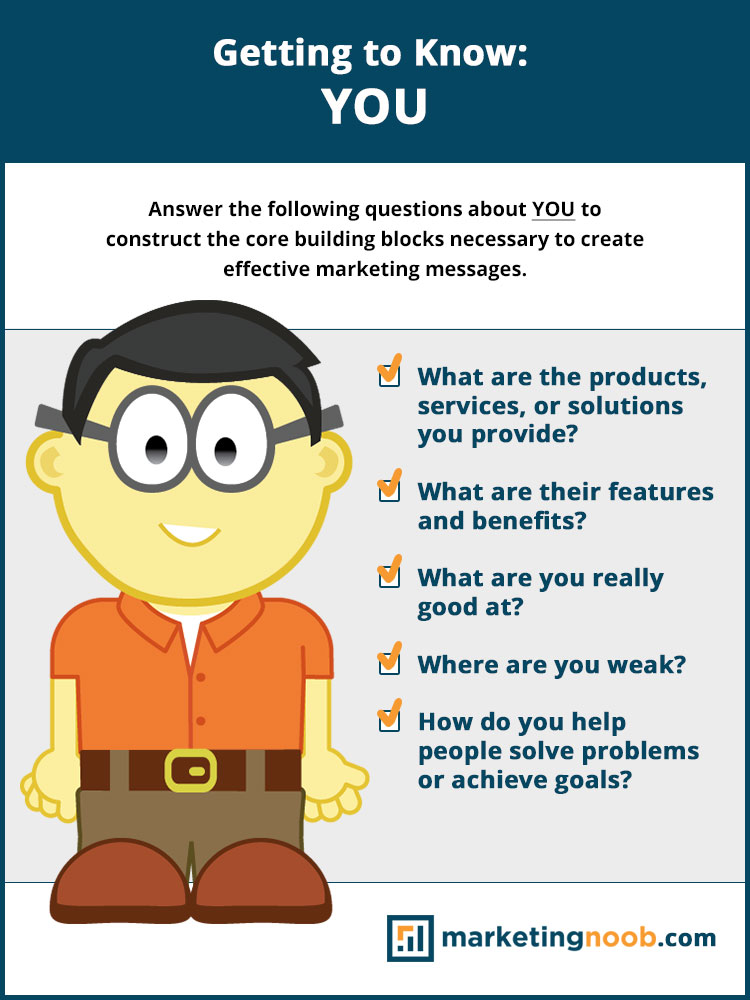
Don’t overthink this too much but keep in mind that is is very important that you are brutally honest with yourself. That goes both ways too. Don’t give yourself too much praise like “I’m the best that ever lived” but, on the same token, don’t be too critical of yourself.
Here are the questions we want to explore to generate the YOU building blocks:
1. What are the products, services, or solutions you provide? – This is a pretty simple one. What are the products, services, or solutions you sell to customers that help them solve their problems or achieve their goals?
2. What are their features and benefits? – Now we are going to jump into the important part of our products, services, and solutions: the features and benefits. Each product, service, and solution has features. They might have a single feature or several. We want to focus on each feature individually and determine the benefit it provides to the customer.
We are going to use a coffee mug as an example. Three features of the coffee mug are the large handle, the size (20 oz.), and it’s made from stainless steel.
Here are the Benefits of each Feature:
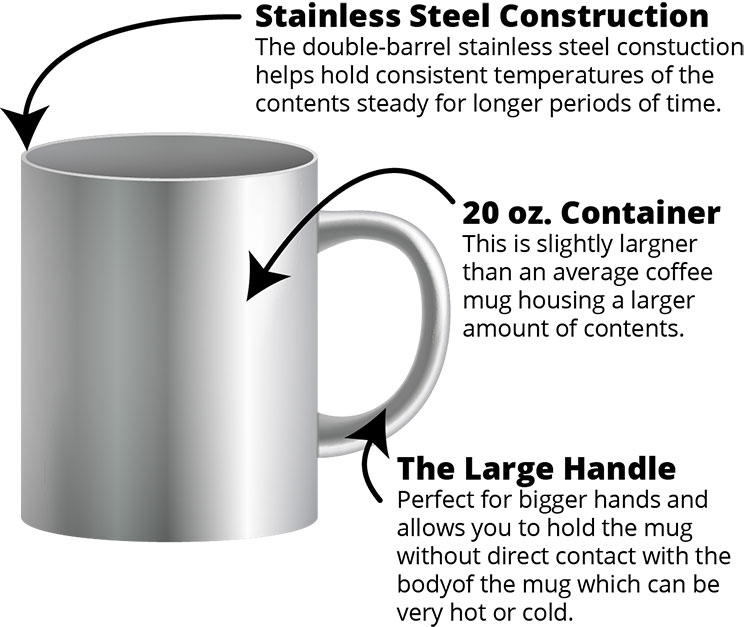
Feature #1: The Large Handle
Benefit of Feature #1: Perfect for bigger hands and allows me to hold my coffee without direct contact with the body of the mug which can be very hot or cold, depending on the contents.
Feature #2: The 20 oz. Size
Benefit of Feature #2: This is slightly larger than an average coffee mug allowing me to take a larger amount of contents with each serving.
Feature #3: The Stainless Steel
Benefit of Feature #3: The stainless steel helps hold the temperature of the contents steady for a much longer period of time preventing hot items from getting cold and vice-versa.
3. What are you really good at?
Unless this is your first day, there is a pretty good chance that you are really good at something.
If you excel in several areas, prioritize them starting with the area you feel is your best.
Explore what makes you really good. Do you have a lot of experience? Is there a particular method you practice or even created that is unique to everyone else? Does your product, service, or solution last longer? Can you achieve an end-result that is clearly above others?
4. Where are you weak? – To be an expert at anything means that you are likely not an expert at some things. The time, devotion, and practice it takes to be an expert in anything are the components that separate you from the rest and make you special. No one is an expert at everything. Where do you not excel? Is there a certain area of your business that you are not as strong?
You might be questioning why we are exploring your weaknesses. Understanding where we are weak is just as important as understanding where we are strong. Creating a marketing message requires that we position ourselves in a certain way. We want to make sure the way we position ourselves plays to our strengths and steers clear of our weaknesses. Don’t lead them to your kryptonite.
5. How do you help customers solve problems or achieve goals? – Now, we are going to tie all these items together. How do the benefits of your product, service, solution features help solve the problems or challenges your buyer personas face?
We’ve already outlined the features and benefits of our 20 oz. Stainless Steel coffee mug.
Here are some of the ways it can help:
A perfect companion for long commutes as it holds a larger amount of coffee and maintains the desired temperature for a longer period of time.
The larger size and handle is perfect for someone with bigger hands and (maybe) a bigger appetite for coffee.
Clarifying the difference between Features, Benefits, and Value
While the benefit is an important component here. We are really trying to convey the value that we are providing. The value is what the customer is going to connect with.
Features are the particular attributes of your product or service that help it function. It could be the 3000 thread count of high-end bed sheets, the 3 gazillion lumens led bulbs in a flashlight, or the high strength and lightweight plastic shield on a piece of farm equipment.
Features are nice but they are things that we (the provider of the product, service, or solution) sometimes get hung up on. We have a tendency to try and showcase features without explaining how they will help accomplish the end goal and overcome the problem or challenge the customer is facing.
Benefits are the result of the features. They are the functionality the feature delivers. Benefits can be positioned to the customer and tied to their goal, problem, or challenge.
Value is how your product, service, or solution will help the customer achieve their goal and/or overcome their problem or challenge. It helps them visualize and relate to how it can help them.
Before moving to the next step, take a moment to outline your Features, Benefits, and Value in the downloadable workbook. This will help you create your Benefit and Value core building blocks.
The core YOU building blocks we need to create and understand for the creation of our marketing messages are:
Now that you’ve outlined the features, benefits, and value your product, service, or solution provides, it’s time to extract the core YOU building blocks.


Getting to Know Your COMPETITORS
Until you completely understand your competition, you can never know how to position yourself to be different in anything other than price.
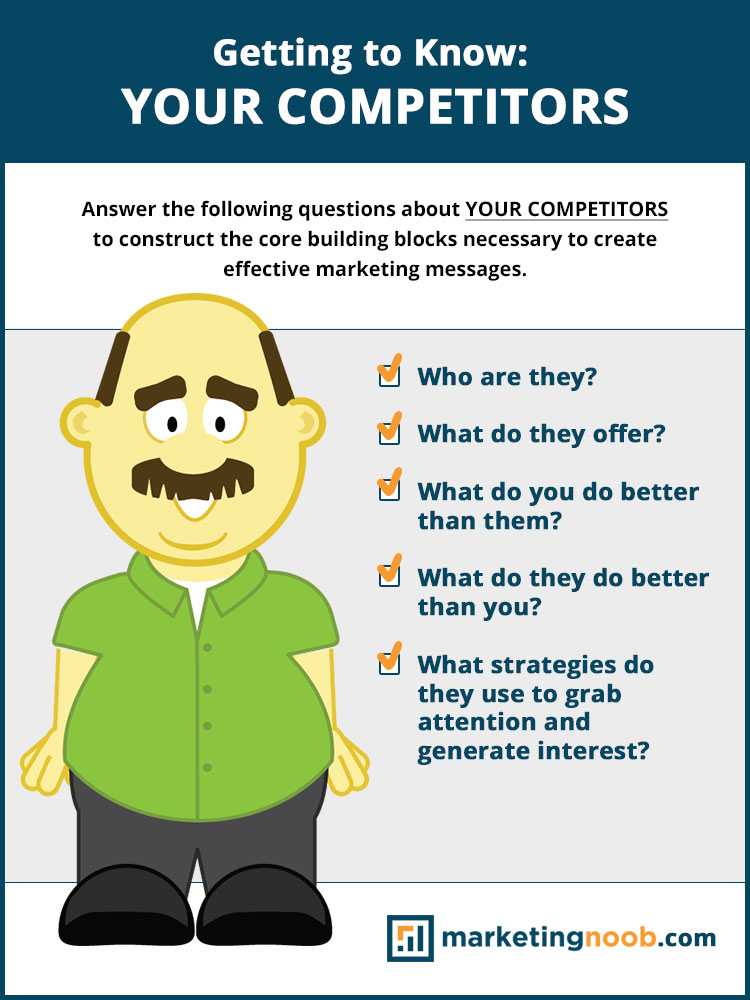
The vast majority of businesses do not want to be positioned as a cheap, economical solution. Chances are, you’ll be judged on price until you can give the customer a reason to consider your more expensive option.
You must be able to clearly present what makes your business different from your competitors.
The only way to uncover these differences is some good old fashion research to fully understand all the other options available to your Buyer Persona.
Here are some questions to explore in gaining a better understanding of your competitors:
- Who are they? – Identify who you are competing with. Approach this from the viewpoint of your Buyer Persona and how they will travel through their buying process or The Buyer’s Journey. You might be surprised to find some new faces that are getting the attention of your potential customers.
- What do they offer? – Make a detailed list of everything each competitor offers. Don’t simply focus on products and services and make the mistake of overlooking their way of conducting business. A customer assumes equality in products and services and focuses their evaluation on things like perception based on appearance, fulfillment, customer service, guarantees, warranties, quick quotes, and educational resources to help them with their buying decision. Be thorough so you are leaving no stone unturned.
- What do you do better than them? – Highlight the areas where you are better than they are.
- What do they do better than you? – Highlight the areas where they hold an advantage over you.
- What strategies do they use to grab attention and generate interest? – How do they position themselves to potential customers? Do they drive focus towards a specialized quote building tool on their website? Do they have a sales team calling leads multiple times to get that initial appointment? Understand the path a potential customer will travel upon first coming into contact with this competitor.
Download The Elevator Pitch Companion Workbook
Use the Exploring Your Competition section of the accompanying Workbook to help outline your competitors and understand what makes you different.
The core COMPETITION building block you need to create and understand for the creation of our marketing messages are:

Creating Your Marketing Messages
Are you ready to start creating your marketing messages?
At this point, you should have explored your CUSTOMER, YOU, and your COMPETITION. During that process, you should have also generated the core building blocks associated with each area.
These Core Building Blocks are:





If you haven’t yet fleshed out the CORE BUILDING BLOCKS, go back and do so now.
The remainder of this exercise will heavily depend on having these core building blocks in place.
Be sure to leverage the accompanying Marketing Message Workbook. You can download it here.
Without further ado, let’s get started creating your Unique Selling Proposition, Value Proposition, and Elevator Pitch!
Creating Your Unique Selling Proposition (USP)

Let’s begin the process of creating your Unique Selling Proposition by defining a USP.
You must be able to clearly define what makes your business truly unique from your competition.
This is where many can get lost in a sea of business cliches like:
- Satisfaction is our #1 priority
- The customer is #1
- We go the extra mile for our customers
- We are the premier provider of services
There are two things wrong here.
First, everyone and I mean everyone, is using these one-liners.
They are so overused that they have no meaning.
Second, these aren’t unique attributes of your business. They are feel-good marketing messages that appear to be polished, professional, and fit the bill for being unique.
The reality is, this is the lazy-man approach to being unique.
The other item that is wrong here is the more important one.
Your customers see through the bullshit.
They expect that you will go the extra mile, satisfy their needs, and put them first since they are paying you money. That is the baseline.
They want to know what makes your product, service, or solution different and better than the other options they’ve been researching.
That is what you need to clearly convey to them.
Ask yourself these questions when creating your USP:
How are you unique?
You should already have uncovered this while creating your Differentiating Factor during the Getting to Know Your COMPETITION section.
If you are struggling with finding true differences, you are not alone. When you break down what you do and who you are doing it for, it can feel that you are not all that different from any of the other competitors. Perhaps that is the case.
Keep this in mind. The less you can clearly separate your business from your competitors, the more the customer is going to base their decision on price.
So dig deep to find something that makes you unique.
Consider that your product is very similar to your main competitors. Separate yourself in other areas. Do you carry a large inventory making it likely you have the product they want in stock? Do you offer free shipping? Do you have an excellent return policy reducing the risk of buying the product online?
Let’s use the online shoes (and much more) store Zappos as an example.
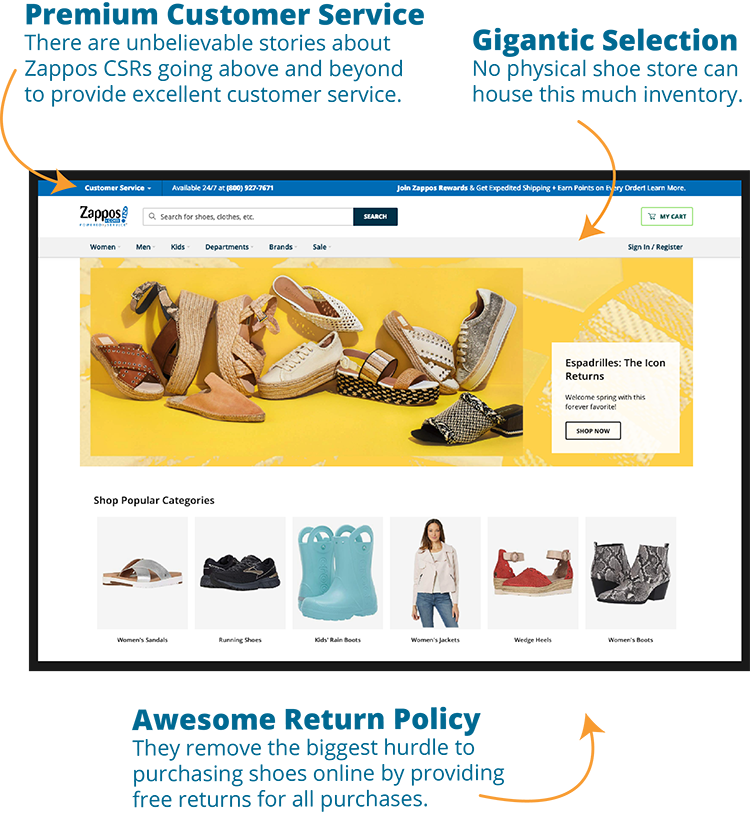
At the core, we are talking about a website that sells shoes and clothing. There are a million of these. They are not manufacturing shoes. They are selling the very same shoes that we can get when we walk into any shoe store on the planet. Their product is absolutely the same.
Where they set themselves apart is how they thrive.
Their selection is gigantic. No physical shoe store (that I’ve been in) carries 10% of what they showcase for sale on their website. Zappos has everything that you could imagine.
Their customer service is spectacular. Call their customer service, just once, and I promise that you will be impressed. Their CSRs are trained to go above and beyond to help their customers.
Their return policy is awesome. One of the big hurdles in buying shoes online is you don’t get the chance to try them on before you purchase them. Zappos allows you to return shoes for free. This totally eliminates the risk of buying shoes that might not fit right.
Zappos is a great example of being different in a space where your product is basically identical.
Who do you help?
Back to the Getting to Know Your CUSTOMER section for this one.
Each of your marketing messages should focus on your buyer personas.
If you operate in a niche market, it makes sense to call out the market that you serve. This can show that you are a specialist to that market and have products, services, and solutions that cater specifically to them. Being a specialist by itself could also be what sets you apart.
ConvertKit does a great job of identifying themselves with a market.
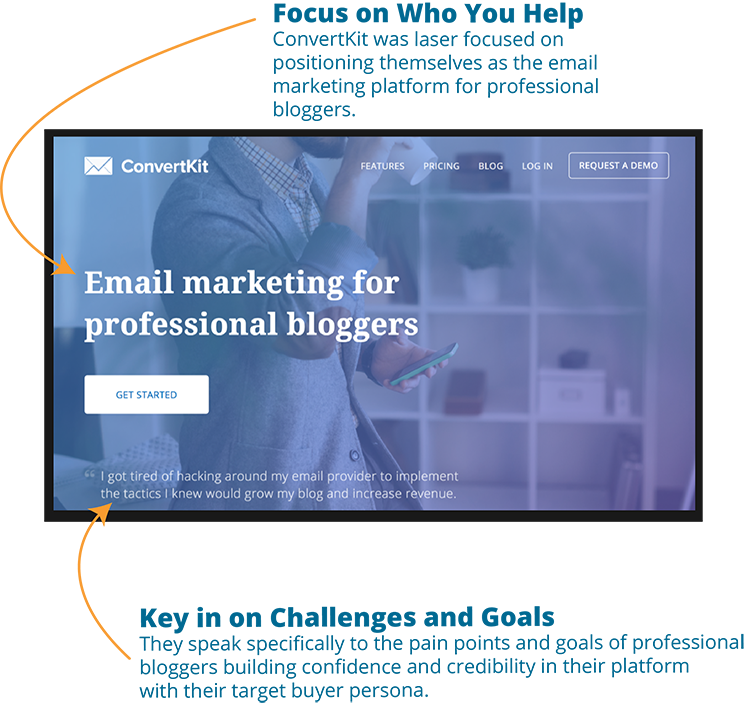
ConvertKit is an email marketing platform built to provide the functionality of InfusionSoft with the ease-of-use and cost of MailChimp. While this might seem to be a difference maker alone, it still seemed like another email marketing platform in a very crowded space of many already established email platforms.
The owner (Nathan Barry) decided to grow the company one vertical at a time. He now positions the company as the email marketing solution for people who make things like bloggers, authors, artists… creators. The content they produce and the emails that they send to inboxes are written to these individuals and create a feeling of community for them inside of ConvertKit.
What problem do you solve?
The USP should address the problem the differentiating factor solves.
This should be a problem your buyer persona is facing and searching for a solution.
Zappos provides hassle-free returns so you can shop a gigantic selection of shoes and return them if they don’t fit.
ConvertKit provides a feature-rich email marketing platform created by creators for creators. This sense of commonality and helps their buyer personas align themselves with the company.
Be specific in defining your problem.
Building Your USP
Let’s get to it and start building your USP.
The core building blocks of a USP are:



Plug your Core Building Blocks into the formula below to begin creating your USP.

Feel free to rearrange the order in any way you wish.
Play with the wording to make the three elements work with one another.
Try coming up with a couple of variations and see which you like best.
Here are USPs examples for Zappos and ConvertKit
Please note, these are not their formal USPs and I’m simply making these up for the purpose of providing an example to reference.
Zappos – Example USP
 = Huge selection, hassle-free returns
= Huge selection, hassle-free returns
 = Shoe lovers
= Shoe lovers
 = People don’t like to buy shoes online because they cannot try them on
= People don’t like to buy shoes online because they cannot try them on
Zappos USP = No risk returns for the shoe lover that wants to shop online
ConvertKit – Example USP
 = Focused on serving creators
= Focused on serving creators
 = People who make things
= People who make things
 = Most SaaS platforms can be overly technical and intimidating
= Most SaaS platforms can be overly technical and intimidating
ConvertKit USP = Easy to understand email marketing for creators
As mentioned before, there is no particular order to position the core building blocks. Just be sure they are all present.
One or Many USPs?
A question often asked is, “Do I create a single USP for my company or multiple USPs for different products and services that I sell?” The answer is both.
It boils down to preference and what best fits.
Some companies have one main product or service that provides a single position of uniqueness to a single buyer persona. Others might have multiple avenues that warrant multiple USPs.
The Exception to the Rule
Below are some of the most notable USPs (on the internet) from popular brands:
- Avis: We’re number two, we try harder.
- FedEx: When it absolutely, positively has to be there overnight.
- M&Ms: The milk chocolate melts in your mouth, not in your hands.
- Domino’s Pizza: You get fresh, hot pizza delivered to your door in 30 minutes or less or it’s free.
Notice that each of these is missing the buyer persona core building block. They are not defining who it is they are trying to engage with. This is because they are marketing to the masses. They consider most of the eyeballs they encounter to be potential buyers of their products or services and therefore feel they do not need to call them out.
This works for them. Will it work for you? Probably not…
Don’t fall into the trap where you think your product or service appeals to everyone and therefore can skip the buyer persona creation process. The importance of creating the buyer persona cannot be stressed enough. Even if you feel that your business is in alignment with FedEx and Domino’s Pizza, it is best practice to go through the buyer persona creation process.
Where to Use Your USP
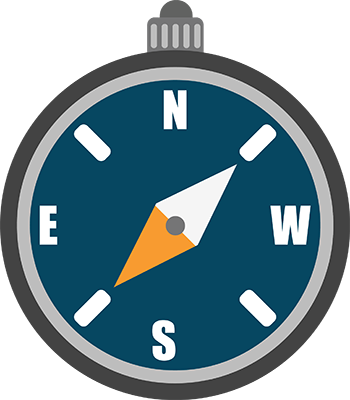
It is helpful to know when and where these marketing messages are best used.
Your Unique Selling Proposition is one of the most versatile marketing messages and can be used in a lot of places.
- Website Home Page – Place your USP as the focal point of the above-the-fold real estate on your website’s homepage. Most sites’ home pages receive the most traffic. The area above-the-fold (what you see on the screen before you scroll down the page) gets the most viewership. Position your top marketing message and call-to-action in this area of your website.
- Landing Pages – Driving traffic to landing pages is a very effective marketing strategy. Use your USP in the headline or other prominent placement on your landing page.
- Billboards, Direct Mail, Newspaper Ads, any form of traditional print media – Your USP is not just for digital vehicles. Be sure they are included in all offline advertising vehicles you are using.
- Retargeting Ads – Continue to drive home your differentiating factor by using your USP in all retargeting campaigns.
- Verbally at Networking Events, Backyard BBQs, Sales Calls, Webinars, and During Meetings – When speaking to one or more people, it is essential to be remembered. A strong USP will help you do this. Rehearse the delivery of your USP so you can speak it as clearly as it is written in online and offline communications.
- Social Media Profiles – Take the description of your social profile up a notch. Save the boring banter everyone else is pushing and position your USP anywhere your customer eyeballs or ears might venture.
Now it’s your turn.
Use the Unique Selling Proposition section of the accompanying Workbook to create your USP.
With your freshly created Unique Selling Proposition in place, it is time to create your Value Proposition.
Creating Your Value Proposition

In a similar fashion, let’s define a Value Proposition.
In other words, what is the value you will provide your buyer persona?
The Value Proposition is a very close relative of the USP.
The center of the Value Proposition is the Value that comes with your product, service, or solution. This Value is a direct result of the Benefit your product, service, or solution provides.
Refresher on Feature vs. Benefit vs. Value
Here is a quick breakdown of the differences:
- Features – the specifics of the product, service, or solution that make it function
- Benefits – the positive results the features provide the end-user
- Value – the way the product helps the customer overcome their goal or challenge
You want to define the value with clarity. The value you provide will be the key element that will attract potential customers to you.
To really dig into this, ask yourself these questions:
- What is the problem that your customer is facing?
- What is the end-benefit of your solution?
- What unique value do you provide to your customers?
Building Your Value Proposition
Now that we’ve covered all the basics, we are ready to build your Value Proposition. Let’s go!
The core building blocks of a Value Proposition are:




Plug your Core Building Blocks into the formula below to begin creating your Value Proposition.
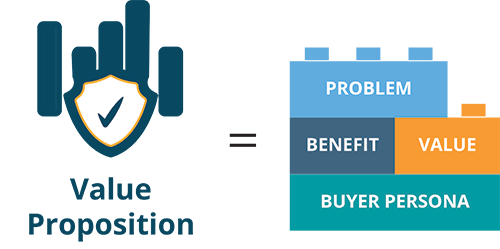
You do not have to keep the Core Building Blocks in this order. Feel free to rearrange them to your preference. Just be sure to include all 4 Core Building Blocks.
Where to Use Your Value Proposition
This is pretty much the same lineup as the USP. In case you forgot, here is that list again.
- Website Home Page
- Landing Pages
- Billboards, Direct Mail, Newspaper Ads, any form of traditional print media
- Retargeting Ads
- Verbally at Networking Events, Backyard BBQs, Sales Calls, Webinars, and During Meetings
- Social Media Profiles
- Just about anywhere your customer eyeballs or ears might venture
Using Your Value Proposition on Your Website
One of the best places to display your Value Proposition is the hero area of your website’s home page.
This is the area of your website that sits above-the-fold and is visible before someone begins scrolling down the page. It is the section of your website that likely receives the most viewership and prime real estate for your most important message.
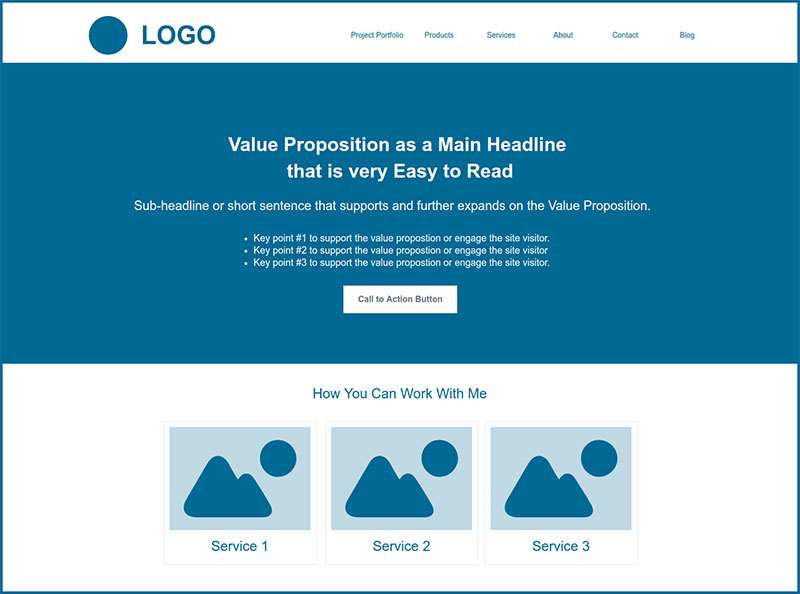
A simple Value Proposition formula for your website:
- Headline – A short sentence that grabs attention and keys in on the value you provide.
- Sub-headline – A more descriptive sentence or two explaining the key benefits of your solution and the problem it solves.
- Visual – A compelling image that supports your statement
- CTA – A clear call-to-action telling the site visitor exactly what you want them to do.
See How Others are Using Value Propositions on Their Websites
Here are some examples of brands positioning their Value Propositions in the hero section of their website’s home page.
Dollar Shave Club
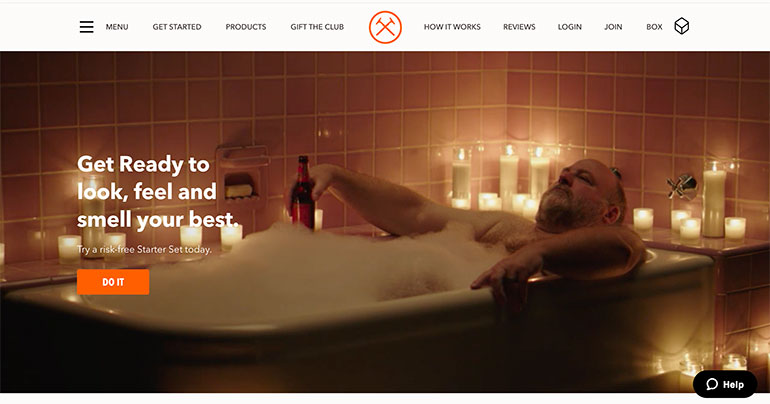
Headline: “Get Ready to look, feel and smell your best.” Dollar Shave Club recently (as of 2018) expanded beyond only razors and now carry additional products.
Sub-headline: “Try a risk-free Starter Set today.” One of the major pain points in the razor industry is the high cost most brands demand for replacement blades. Dollar Shave Club hangs their hat on providing members of their club with the same quality razor blades and close shave as the high dollar brands without paying the premium price.
Visual: Dollar Shave Club displays a video showing various people shaving, bathing, grooming, etc. in the bathroom. This is a simple display of the product in action. Different people of types using Dollar Shave Club products to look, feel and smell their best.
CTA: Bright orange button that reads “Do It”.
Stripe
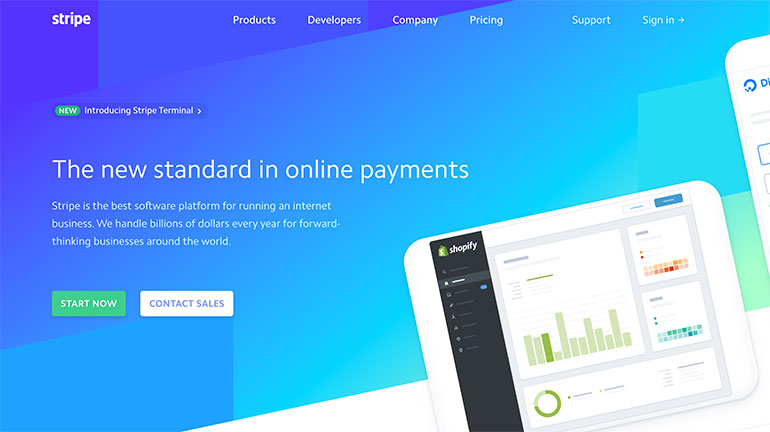
Headline: The headline reads “The new standard in online payments”. It eludes to the fact that Stripe is now what more and more people are choosing over PayPal or a merchant account and gateway setup with their bank.
Sub-headline: “Stripe is the best software platform for running an internet business. We handle billions of dollars every year for forward-thinking businesses around the world.” The sub-headline directly notes this software was created for running an online business. Mentioning they handle “billions of dollars every day for forward-thinking businesses around the world” validates that a lot of transactions run through their platform all around the world for a large number of businesses who value using technology that just works the way it should.
Visual: An engaging background image with screenshots of popular ecommerce platforms like Shopify.
CTA: There are two buttons being used as CTAs. The green button labeled “Explore the Stack” leads to more information for the site visitor that wants to learn more. The white button labeled “Create Account” is for those ready to get started.
Sumo
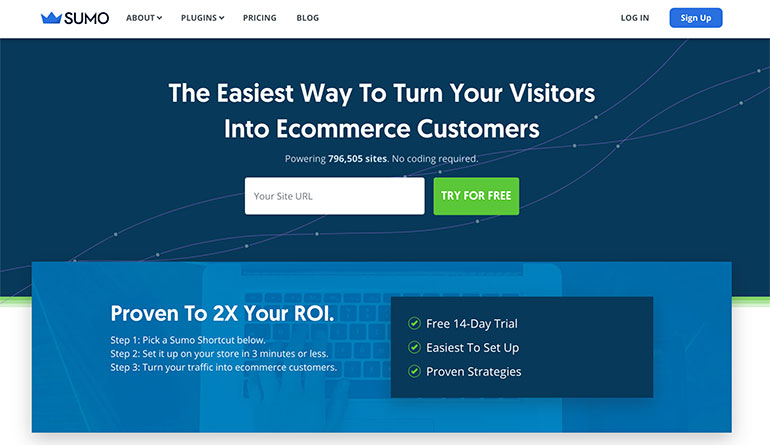
Headline: “The Easiest Way To Turn Your Visitors Into Ecommerce Customers.” Sumo provides a group of tools that help you grow your online presence. They have a free version to get you started. In the headline, they clearly state their tools help turn website visitors into customers for good reason. This is one key item anyone with a website will find valuable.
Sub-headline: “Powering 796,505 sites. No coding required.” They combine social proof that lots of people use their tools by posting a staggering number of sites using Sumo and address the big coding objection many have with installing website tools.
Visual: Bold blue background that with contrast against the white text.
Bullet points:
- Free 14-Day Trial – Reduces risk by allowing the visitor to try the product for 14-days before they buy it.
- Easiest to Set Up – Again, one of the bigger barriers for many is the installation of website tools. Many require coding knowledge usually resulting in more time and/or having to hire someone to help get everything set up. This is not the case with Sumo.
- Proven Strategies – The only thing better than awesome tools is directions on how to get the most out of them. Sumo provides proven strategies that take the guesswork out of using their products.
CTA: Sumo uses a form field to enter your website URL to get started. They make it stupid-simple to get started.
Use the Value Proposition section of the accompanying Workbook to create your Value Proposition.
At this point, you should have a Unique Selling Proposition and a Value Proposition in place. It’s time to move on to creating your Elevator Pitch.
Creating Your Elevator Pitch
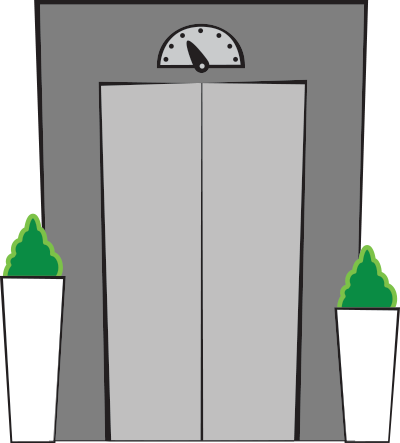
The Need For an Elevator Pitch
If you think an elevator pitch seems old school, like something that you’d see Don Draper flawlessly delivering on his way down the ivory tower to happy hour, you are not alone.
The term “Elevator Pitch” is more about quantifying the duration of the speech and driving the point that this speech should be the best short version of your pitch you can craft.
No one ever bought anything in an elevator
“The purpose of an elevator pitch is to describe a situation or solution so compelling that the person you’re with wants to hear more even after the elevator ride is over.”
~ Seth Godin
As you begin to build your elevator pitch, here are some key things to keep in mind.
- Keep it Short and Simple – Approximately 20 – 30 seconds in length. The length of a short elevator ride.
- Get to the Point – Be sure that you immediately grab their attention and make them want to learn more. Do not waste precious time talking about you and your company. Get to the WIIFT (what’s in it for them) as quickly as possible.
- Be Clear and Do Not Make Assumptions – Paint a clear picture of what you do, who you do it for, and the unique value you provide. Cover the basics and do not assume the person you are speaking understands technical jargon or industry terms. Make it easy to understand.
- Show Them What They Get – Include your USP and/or your Value Proposition.
- Get Them Talking – Conclude with an open-ended question that engages someone in a conversation.
The core building blocks of an Elevator Pitch are:
[Positioning Statement] – This is a statement or question identifying a common problem the person you are speaking to can relate to.
[Compelling Overview] – This is a well-structured overview of what you do and who you do it for. The USP and/or Value Proposition are used here.
[Unique Selling Proposition] – This is the USP you crafted showcasing what makes you different from others.
[Value Proposition] – This is the Value Proposition you created that positions the benefit and value you provide.
[Closing Question] – This is a question directed to the person you are talking to that (hopefully) engages them to continue the conversation or request to meet again and learn more.
Before we get started in building your Elevator Pitch. Let’s talk about a couple of things.
Try to Make it a Conversation
Your Elevator Pitch will likely hold the form of a conversation more than the form of a speech where you speak continuously from start to finish.
This is why we open with a Positioning Statement and end with a Closing Question. We want to engage the person we are speaking to in a conversation.
This actually allows you to drive home all the key components of your Elevator Pitch in a less “pitchy” way.
Have Several Positioning Statements Prepared
The positioning statement is the door-opener.
It is a friendly statement or question to establish commonality and build rapport. It also allows you to perform your elevator pitch to someone you’ve never met and know nothing about.
Perhaps you are standing next to someone on the train who is holding a travel mug of hot contents you assume is coffee.
You could open with something like:
“Are you a coffee or tea person? What brand of flavor do you like best?”
“How do you like that mug?”
These are very easy conversation starters that will hopefully begin some two-way dialog. The idea here is to uncover an angle you can use to segue into your Compelling Overview and USP/Value Proposition.
If you jump into this too quickly and without at least a little engagement, you are going to look like the goon on the train pitching his latest and greatest.
Forget a Script, Just Know Your Key Points
Since you are engaged in a conversation, a script probably will not work.
Based on the response you get from your positioning statement, you may need to switch things up a bit and get creative. Scripts are rigid and do not allow for this flexibility.
Instead, focus on your key points. The things that apply in every situation. This is where knowing all of your Core Building Blocks from creating your USP and Value Proposition is perfect.
Master The Close
The entire point of your Elevator Pitch is to generate enough interest for the conversation to continue immediately or at a future time. Either way, the message was powerful enough to create a desire to learn more.
The closing question might be the most important component.
You can crush it with the positioning statement, your compelling overview, and a killer USP only to blow it because your closing question was weak.
Have a couple of closing questions prepared as well that can fit the flow of the conversation.
The closing questions should be structured to lead to the desired outcome of the elevator pitch.
If you want someone to become a follower of your blog, ask them if you can send them an email with a couple of your best articles and if they’d like to receive future content.
Here are some Closing Question examples.
“There are a couple of articles I’ve written on the topic of [XYZ] that dive deep into what we are talking about. I could email those to you and my new content as its published. What’s your favorite email address?”
If you are looking to schedule an appointment to further explain your complicated concept, ask for the appointment.
“I’m obviously only able to scratch the surface during this quick conversation. There is an overview I’ve put together that explores [XYZ] in more detail and will give you the whole picture. Do you have time to grab coffee this week or time I could swing by your office?”
The key here is to try and get some sort of action out of your elevator pitch.
Do not simply walk on stage, perform, and leave the stage satisfied with potential applause. Make sure you ask each member of the audience to buy tickets for the encore presentation.
Finally, the equation for creating your Elevator Pitch

Note: You can play with the order of the elevator pitch blocks but I’d recommend initially trying this sequence.
- Positioning Statement
- Compelling Overview
- Value Proposition
- Unique Selling Proposition
- Closing Question
The important thing is to cover all the points and make it a fluid conversation.
Where to Use Your Elevator Pitch
Your elevator pitch will likely be delivered in conversation by you either in person or on the phone.
This makes rehearsing your elevator pitch important. As mentioned before, you don’t want to sound scripted. This should be a naturally flowing conversation. You want to know your key points so you can be sure to cover them without getting jammed up if the path of your conversation does not follow a rigid script you’ve memorized.
Most of the time, you will be prepared to present your Elevator Pitch. Those instances are:
- Appointment with a potential customer
- Calling a potential customer on the phone
- Potential investor meetings
- Networking events
- Webinars
Occasionally, you will meet someone unexpectedly who really needs to hear your Elevator Pitch. This could be:
- Someone you meet on the commute to the office
- One of the company executives on the elevator in your office building
- An industry influencer you finally get to meet at a conference
- Golfing with Uncle Teddy and his neighbor who would be a perfect investor for your startup
Make a Video of Your Elevator Pitch
Creating a video of your Elevator Pitch can help you deliver your message to a large audience. Those coming to your website.
You are not going to have the chance to speak to each and every one of your website visitors. They simply do not want to talk to you.
However, you can give them access to a video containing your Elevator Pitch on your website. This will allow them to digest you and your message themselves.
Consider shooting a video for each positioning question that you’ve crafted. Visitors to your website will be facing different problems your solution can address. Having a video version of your Elevator Pitch that opens with various positioning questions will appeal to a larger audience.
Place these videos in the sections of your website with related content.
Key Takeaways and Action Items
Now it is time for you to get started creating your Unique Selling Proposition, Value Proposition, and Elevator Pitch.
If you made it this far and feel like there is a lot of work to do, you are right. Creating your marketing messages is not something you will knock out in an hour. It will take some time.
The process has been broken down into convenient bite sizes. Take it at your own pace.
Once you are finished with this process and have your Unique Selling Proposition, Value Proposition, and Elevator Pitch, you will quickly notice a difference in how people react to your marketing messages.
Here is a quick checklist that you can follow that will take you from the start all the way through the finish line.
- Start by downloading the accompanying workbook. It will help guide you along the way.
- Get to know YOURSELF, Your CUSTOMER, and Your COMPETITORS.
- Create the Core Building Blocks for your marketing messages.
- Create your USP, Value Proposition, and Elevator Pitch.
- Place your Value Proposition on your website.
- Practice delivering your marketing messages as much as you can.
- Get feedback from customers and experiment with split testing.
- Revisit and revise your marketing messages to continuously improve them.

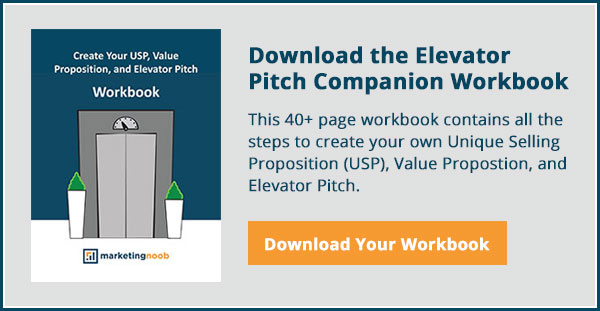
Comments